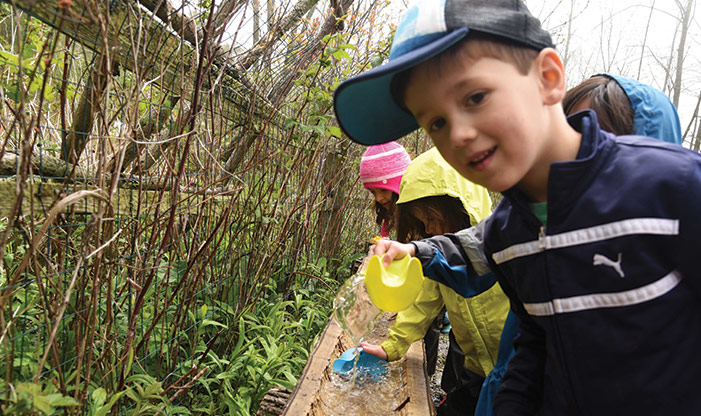Our Nature Preschool students have a new reason to cheer for rain! More water means more fun playing with the sluiceway, a new feature in the Garden Playspace. Who says green infrastructure can’t be entertaining?
What’s a Sluiceway and Why Have One?
A sluiceway is simply an artificial water channel for carrying off overflow or surplus water. This concept inspired the Center’s conservation team, who were looking for a way to control chronic water problems in the Garden Playspace. Four thousand square feet of roof runoff flows into this area during rain events. Very heavy storms had caused flooding several times. Standing water often made a large portion of the area unusable, even for mud-loving preschoolers!
Thanks to a grant from the Southeast Wisconsin Watershed Trust, or Sweet Water, the Center’s conservation team was able to put the sluiceway concept to work in a creative way to solve this water problem. The result is a cool, open-air stormwater capture system that doubles as a play feature!
How the Sluiceway Works
Our sluiceway first solves the flooding problem by capturing roof runoff in a huge water tank. The tank is outfitted with a special valve, accessed from the playspace. When it’s opened it sends water through a 30-foot sluiceway built of hollowed and halved ash logs. As an interactive element in our preschool playspace, kids love activating their very own “river.” They float leaves and sticks through the sluiceway, and make mud whenever possible.
The second problem solved by the system is that of moving the water away from the building. Once it flows through the sluiceway, thoroughly delighting preschoolers, the water ultimately flows into a series of rain gardens. When it reaches the raingardens, the water can safely pool until absorbed. The process of evapotranspiration will also release water back into the atmosphere.
In addition to dealing with stormwater, the sluiceway touches on another ecological issue the Center is facing. How can we use trees felled due to Emerald Ash Borer? EAB has been decimating the Center’s ash trees. We have already cut more than 700 trees that could have posed a hazard to people or structures due to their location. While most resulting logs are left on the land to from additional habitat, we repurpose others. Creating a unique play structure for our preschool students is just one fun way to do that.
Two-Fold Mission
Schlitz Audubon’s mission is to conserve our land’s diverse habitats on Lake Michigan and provide meaningful experiences and environmental education for all. Like many of the initiatives we undertake here at Schlitz Audubon, the sluiceway fulfills both the conservation and education components of our mission.
Next time you walk the trail that runs parallel to the front of our education center, check out the interpretive sign at the second rain garden. It gives a little more detail on the benefits of rain gardens, showing creative, beautiful, easily replicated examples of stormwater management. Through this educational effort, we hope to foster an increase in stormwater pollution prevention throughout the community.


